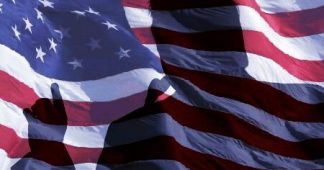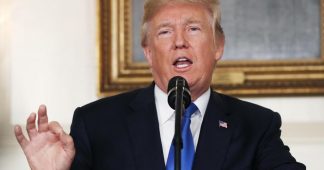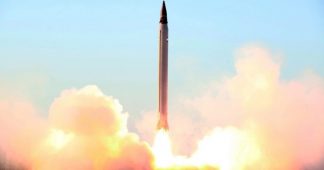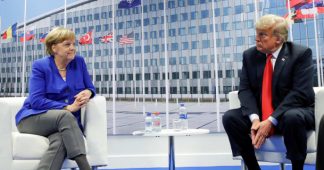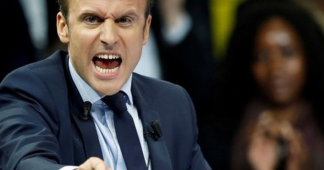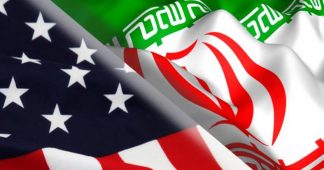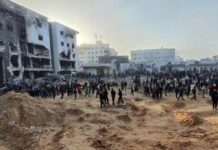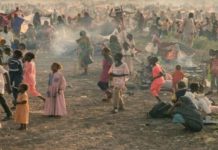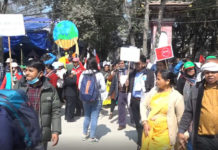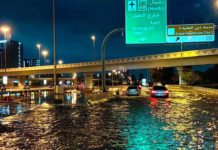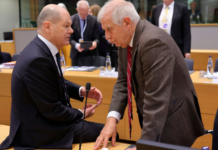The Trump administration believes that ratcheting up economic pressure on Iran will compel the Islamic Republic to curtail its disruptive Middle East policies. History suggests otherwise. Both Washington and Tehran should step off their current escalatory path.
2 November 2018
What’s new? A 40-year analysis of Iran’s economic performance and regional policy reveals little to no correlation between the two, as Tehran has continued to pursue policies it deems central to its national security no matter its degree of economic wellbeing at home.
Why does it matter? The Trump administration hopes that sanctions will force Iran to curb its regional activities. But data shows that outcome is uncertain as changes in Iran’s wealth have had little impact on the direction or capabilities of its regional policy. Sanctions risk empowering harder-line officials in the Islamic Republic and prompting them to lash out, exacerbating regional tensions.
What should be done? The U.S. optimally should leverage its sanctions to de-escalate regional tensions. That requires acknowledging Iran’s legitimate security concerns as long as Iran acknowledges those of its regional rivals. However unlikely at this time, the U.S., Iran and Gulf Arab states should take steps to build a more stable regional security architecture.
I. Overview
The intuitive presumption at the heart of the Trump administration’s policy toward Iran is that, by reducing its resources, economic sanctions on Iran will diminish its disruptive activities abroad. The sanctions that the U.S. Treasury Department will re-impose on Iran on 5 November are, in the words of Secretary of State Mike Pompeo, intended to push Iran into making a choice: “either fight to keep its economy off life support at home or keep squandering precious wealth on fights abroad. It won’t have the resources to do both”.
But historical data shows little, if any, correlation between the resources at Iran’s command and its regional behaviour. Rather, the extent to which the Islamic Republic feels threatened or senses opportunity in its neighbourhood largely defines its conduct. Measured against that standard, the Trump administration’s aggressive policy is likelier to spur Iran’s regional activism than to curb it. A better alternative exists. It would require the Trump administration not to ignore Iran’s regional interests, but to acknowledge that it has legitimate security concerns, and for Iran to acknowledge that as long as it pursues policies that its neighbours and others perceive as aggressive, tensions will persist and the risk of direct military confrontation will rise. A more stable region is possible only if the U.S. moves to provide Iran with viable security assurances, in return requiring that Tehran allow its non-state allies to integrate into their countries’ security and political systems and halt proliferation of ballistic missile technology across the region. Though currently a remote aim, both sides should work with other regional actors toward an inclusive security architecture.
II. Contrasting Eras of Iranian Regional Policy
Studying how Iran has devised its regional policies over the last four decades reveals that its choices have rarely been a function of its economic performance or resource availability.
A. “Forward Defence”
Iran’s regional defence policy was defined and shaped at a time of economic scarcity. Its “forward defence” policy – an effort to exploit weak states, such as Lebanon and post-2003 Iraq, where it can expand its influence and fight through proxies without direct harm or threat to itself – originated in the 1980s.
Then, the newly established order in Tehran, which aspired to export its revolution abroad, simultaneously felt besieged by foreign and domestic enemies seeking to undermine it and isolated in the face of invasion by Saddam Hussein’s Iraq, armed to the teeth by Arab and Western states.
At the time, Iran suffered extreme economic hardship due to revolutionary turmoil, the devastating war with Iraq and falling global oil prices. Yet as shown in Graph 1, Iran’s creation of Hizbollah in Lebanon in 1982, the bombing of the U.S. Marine barracks in Beirut the following year, and a series of targeted terrorist attacks in Europe (in which Europeans saw Iran’s hand) occurred amid falling oil revenues and economic downturn.
A wealthy Iran may well have acted even more aggressively insofar as it would have had more resources at its disposal. But the point is that economic deprivation did not moderate the Islamic Republic’s conduct, make it more inwardly focused or lead it to rein in its regional proxies.

The ensuing decade (1988-1998) was marked by post-war reconstruction amid rising oil revenues (due in part to heightened global oil prices in the aftermath of the first Gulf War) and runaway inflation. None of this, however, appears to have produced any tangible change in Iran’s backing for Hizbollah in Lebanon or Hamas and Islamic Jihad in Palestine. Nor did the 1997 Asian financial crisis that caused oil prices to collapse and Iran’s oil revenue to fall from $16.7 billion in 1997 to $9.7 billion in 1998. In other words, the trajectory of Iranian foreign policy was essentially impervious to the fluctuations in its economic wellbeing.
B. Pragmatism and Diplomacy
Iran’s destabilising activities declined in the early 2000s when, as shown in Graph 2, both oil proceeds and gross domestic product (GDP) were on the rise. During this period Iran significantly improved its relations with its Arab neighbours, helped the U.S. in working on the post-Taliban order in Afghanistan, and briefly suspended its nuclear program in negotiations with the Europeans – though it admittedly continued to support Hizbollah and other non-state actors in the Levant.
Again, this hardly demonstrates that Tehran acts more responsibly when its economy performs better; non-economic reasons – notably the more pragmatic perspective of Iran’s reformist government at the time and concerns about a possible U.S. attack after its 2003 invasion of Iraq – can help explain Iran’s behaviour. But it underscores that realities other than the resources at its disposal determine Iran’s policy choices.

Between 2003 and 2011, Iran had two key priorities. First, it worked to ensure that in the aftermath of the U.S. invasion of Iraq a central government would emerge in Baghdad that, while strong enough to keep the country together and secure its borders with Iran, was not so strong as to once again pose a threat. Second, it aimed to push U.S. forces out of its western neighbour’s territory. To achieve the former, it relied on relationships it had cultivated for decades with Iraqi leaders (particularly Shiite Islamists and Kurds); for the latter, it trained and equipped several Shiite militias that targeted U.S. forces in Iraq. This period coincided with the nuclear standoff and imposition of a panoply of unilateral, multilateral and international sanctions. But Tehran was nevertheless flush with money thanks to high oil prices. Again, this shows that its policy of backing non-state actors has remained largely consistent in good economic times as well as bad. As a senior Iranian official put it, “when you rely on a [‘forward defence’] strategy for your survival, you rely on it come hell or high water”.
C. Regional Escalation
As evidence that economic downturns do not necessarily curb Iranian regional activism, the most telling period is 2011-2015 (see Graph 3). A stifling web of multilateral and international sanctions inflicted maximal harm on the country’s economy, which shrank at the rate of 7.7 per cent in 2012 as oil exports declined by half, the currency fell by 200 per cent and inflation rose to almost 40 per cent. Yet this period coincided with what many consider the most significant expansion of Iran’s military intervention in the region, a product of the uprising in Syria, Tehran’s growing rivalry with Riyadh and the fight against the Islamic State.

According to the Stockholm International Peace Research Institute, Iran’s arm transfers to allies in Syria and Iraq peaked in this period.
Resource scarcity at home neither prevented Iran from extending a multibillion line of credit to Damascus nor from mobilising Shiite militias from Afghanistan, Pakistan and Iraq to fight in Syria. Iran also stepped up its support for Yemen’s Huthi rebels, training and equipping them.
D. Post-Nuclear Deal Boon?
Critics of the 2015 Joint Comprehensive Plan of Action (JCPOA) contend that Iran grew more belligerent in the aftermath of the nuclear accord, which provided it with billions of dollars in unfrozen assets. Yet it is hard to point to anything Iran did after the deal – from supporting Yemen’s Huthi rebels to propping up the Syrian regime – that it was not undertaking prior to the agreement.
There was one notable change: a nearly 30 per cent increase in the country’s military budget.
Even that should be assessed in the right context. As shown in Graph 4, the 2016 bump brought spending back to 2009 levels – not to a new high. More importantly, Iran was broadening its regional involvement at a time when it was spending less on its military (2011-2015), suggesting that this expansion is a product of opportunity or perceived necessity, not economics, and that the increase in defence spending does not necessarily have a discernible impact on the ground.

Besides, Tehran’s military expenditure likely is not in and of itself a main U.S. concern. In 2017, Iran’s annual defence spending of $16 billion paled in comparison to Saudi Arabia’s $76.7 billion.
Iran spent less than 3 per cent of its GDP on defence (where sectoral spending ranks fourth in per capita terms after social insurance, education and health), not excessive for a country of its size.
Iran’s activities in the region are inherently – and deliberately – inexpensive and thus largely impervious to economic fluctuations. The Trump administration contends that Iran has spent $16 billion to project power in the region since 2012. If accurate – though the figure is likely inflated – that makes for an average of $2.6 billion per year. This is not an onerous expense for a country that, even under sanctions, will reap more than $25 billion in oil revenues in 2019 and holds more than $100 billion in foreign reserves.
III. The Perils of a Sanctions Backlash
Iran may well choose to tactically retreat or halt certain activities, as it has in the past. It is likewise logical that when it has additional resources it can continue expanding its regional footprint. But nothing in the history of the Islamic Republic suggests that sanctions will prompt a substantive shift in its foreign policy. To believe otherwise is to misunderstand the sources of Tehran’s conduct, predicated on the notion that strategic depth, achieved through backing allies, partners and proxies, is vital for its national security. Israel’s invasion of Lebanon in 1982, the U.S. invasion of Iraq in 2003 and the Saudi-led war in Yemen since 2015 allowed Iran to exploit chaos and deepen its clout. In all these cases, it took advantage of its adversaries’ mistakes and filled security vacuums created by failing states.
For now, banking on the remaining signatories to the JCPOA’s effort to provide it with an economic lifeline in the face of unilateral U.S. sanctions, Tehran appears to be pursuing a relatively cautious path in the region.
It has largely refrained from responding militarily to more than 200 Israeli strikes on its assets in Syria and engaging in skirmishes with the U.S. Navy in the Strait of Hormuz.
Paradoxically, however, Tehran could become less risk-averse if Washington were to succeed in crippling its economy. As a senior Iranian official put it, “if the economy spirals out of control, the leadership in Tehran will welcome a crisis that could change the subject domestically and rally the population round the flag”.
Given the high level of friction between Iran, the U.S. and their respective allies in the region, such a clash could easily spiral into a disastrous conflict.
Read more at https://www.crisisgroup.org/middle-east-north-africa/gulf-and-arabian-peninsula/iran
